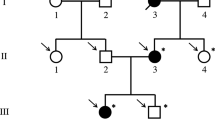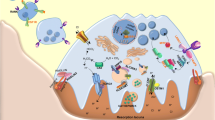Abstract
Proteus syndrome is a rare genetic disorder, which is characterized by progressive, segmental, or patchy overgrowth of diverse tissues of all germ layers, including the skeleton. Here, we present a 9-year-old girl with a somatic-activating mutation (c.49G > A; p.Glu17Lys) in AKT1 gene in a mosaic status typical for Proteus syndrome. She presented with hemihypertrophy of the right lower limb and a “moccasin” lesion among others. A transiliac bone biopsy was analyzed for bone histology/histomorphometry as well as bone mineralization density distribution (BMDD) and osteocyte lacunae sections (OLS) characteristics based on quantitative backscattered electron imaging. Bone histomorphometry revealed highly increased mineralizing surface (Z-score + 2.3) and mineral apposition rate (Z-score + 19.3), no osteoclasts (Z-score − 2.1), and an increased amount of primary bone in the external cortex. BMDD abnormalities included a decreased mode calcium concentration in cancellous bone (Z-score − 1.7) and an increased percentage of highly mineralized cortical bone area (Z-score + 2.4) compared to reference. OLS characteristics showed several differences compared to reference data; among them, there were the highly increased OLS-porosity, OLS-area, and OLS-perimeter on the external cortex (Z-scores + 6.8, + 4.4 and 5.4, respectively). Our findings suggest that increased bone formation reduced matrix mineralization in cancellous bone while the enhanced amount of primary bone in the external cortex increased the portion of highly mineralized cortical bone and caused OLS-characteristics abnormalities. Our results indicate further that remodeling of primary bone might be disturbed or delayed in agreement with the decreased number of osteoclasts observed in this child with Proteus syndrome.




Similar content being viewed by others
References
Cohen MM, Hayden PW (1979) A newly recognised hamartomatous syndrome. Birth Defects Orig Artic Ser 15(5B):291–296
Cohen MM Jr (2014) Proteus syndrome review: molecular, clinical, and pathologic features. Clin Genet 85:111–119. https://doi.org/10.1111/cge.12266.Review
Lindhurst MJ, Brinster LR, Kondolf HC, Shwetar JJ, Yourick MR, Shiferaw H, Keppler-Noreuil KM, Elliot G, Rivas C, Garrett L, Gomez-Rodriguez J, Sebire NJ, Hewitt SM, Schwartzberg PL, Biesecker LG (2019) A mouse model of Proteus syndrome. Hum Mol Genet 28:2920–2936. https://doi.org/10.1093/hmg/ddz116
Cohen MM Jr (2005) Proteus syndrome: an update. Am J Med Genet C Semin Med Genet 137C(1):38–52
Happle R, Steijlen PM, Theile U, Karitzky D, Tinschert S, Albrecht-Nebe H, Kuster W (1997) Patchy dermal hypoplasia as a characteristic feature of Proteus syndrome. Arch Dermatol 133:77–80
Hoey SE, Eastwood D, Monsell F, Kangesu L, Harper JI, Sebire NJ (2008) Histopathological features of Proteus syndrome. Clin Exp Dermatol 33:234–238. https://doi.org/10.1111/j.1365-2230.2007.02601.x
Sansom JE, Jardine P, Lunt PW et al (1993) A case illustrating Proteus and Klippel-Trenaunay syndrome overlap. J Royal Soc Med 86:478–479
Hotamisligil GS, Ertogan F (1990) The Proteus syndrome: association with nephrogenic diabetes insipidus. Clin Genet 38:139–144. https://doi.org/10.1111/j.1399-0004.1990.tb03562.x
Biesecker L (2006) The challenges of Proteus syndrome: diagnosis and management. Eur J Hum Genet 14:1151–1157
Turner JT, Cohen MM Jr, Biesecker LG (2004) Reassessment of the Proteus syndrome literature: application of diagnostic criteria to published cases. Am J Med Genet A 130A:111–122
Beachkofsky TM, Sapp JC, Biesecker LG, Darling TN (2010) Progressive overgrowth of the cerebriform connective tissue nevus in patients with proteus syndrome. J Am Acad Dermatol 63:799–804
De Becker I, Gajda DJ, Gilbert-Barnes E, Cohen MM Jr. (2000) Ocular manifestations in Proteus syndorme. Am J Med Genet 92:350–352
Cohen MM Jr. (2001) Causes of premature death in Proteus syndrome. Am J Med Genet 101(1):1–3
Fryns JP (1995) Late-onset isolated cystic hygroma. A first clinical sign of Proteus syndrome (Letter). Prenat Diagn 15:96–97
da Costa OM, Pizarro CB, Graziadio C, Chem RC (1999) Proteus syndrome: a possible case associated to precocious puberty. Clin Dysmorphol 8:229–231
Roschger P, Fratz P, Eschberger J, Klaushofer K (1998) Validation of quantitative backscattered electron imaging for the measurement of mineral density distribution in human bone biopsies. Bone 23:319–326
Schneider CA, Rasband WS, Eliceiri KW (2012) NIH Image to ImageJ: 25 years of image analysis. Nat Methods 9:671–675
Glorieux FH, Travers R, Taylor A et al (2000) Normative data for iliac bone histomorphometry in growing children. Bone 26:103–109
Roschger P, Gupta HS, Berzlanovich A et al (2003) Constant mineralization density distribution in cancellous human bone. Bone 32:316–323
Fratzl-Zelman N, Roschger P, Misof BM et al (2009) Normative data on mineralization density distribution in iliac bone biopsies of children, adolescents and young adults. Bone 44:1043–1048
Blouin S, Fratzl-Zelman N, Glorieux FH, Roschger P, Klaushofer K, Marini JC, Rauch F (2017) Hypermineralization and high osteocyte lacunar density in osteogenesis imperfecta Type V bone indicate exuberant primary bone formation. J Bone Miner Res 32:1884–1892. https://doi.org/10.1002/jbmr.3180
Parfitt AM, Travers R, Rauch F, Glorieux FH (2000) Structural and cellular changes during bone growth in healthy children. Bone 27:487–494. https://doi.org/10.1016/s8756-3282(00)00353-7
Cohen MM Jr. (2003) Mental deficiency, alterations in performance, and CNS abnormalities in overgrowth syndromes. Am J Med Genet C Semin Med Genet 117C(1):49–56
Kalhor M, Parvizi J, Slongo T, Ganz R (2004) Acetabular dysplasia associated with intra-articular lipomatous lesions in proteus syndrome. J Bone Joint Surg 86:831–834
Biesecker LG, Sapp JC. Proteus Syndrome. 2012 Aug 9 [Updated 2019 Jan 10]. In: Adam MP, Ardinger HH, Pagon RA, et al. (eds). GeneReviews® [Internet]. Seattle (WA): University of Washington, Seattle; 1993–2021. https://www.ncbi.nlm.nih.gov/books/
Keppler-Noreuil KM, Baker EH, Sapp JC, Lindhurst MJ, Biesecker LG (2016) Somatic AKT1 mutations cause meningiomas colocalizing with a characteristic pattern of cranial hyperostosis. Am J Med Genet A 170:2605–2610. https://doi.org/10.1002/ajmg.a.37737
Akgumus G, Chang F, Li MM (2017) Overgrowth syndromes caused by somatic variants in the phosphatidylinositol 3-kinase/AKT/mammalian target of rapamycin pathway. J Mol Diagn 19:487–497. https://doi.org/10.1016/j.jmoldx.2017.04.001
Lindhurst MJ, Sapp JC, Teer JK, Johnston JJ, Finn EM, Peters K, Turner J, Cannons JL, Bick D, Blakemore L, Blumhorst C, Brockmann K, Calder P, Cherman N, Deardorff MA, Everman DB, Golas G, Greenstein RM, Kato BM, Keppler-Noreuil KM, Kuznetsov SA, Miyamoto RT, Newman K, Ng D, O’Brien K, Rothenberg S, Schwartzentruber DJ, Singhal V, Tirabosco R, Upton J, Wientroub S, Zackai EH, Hoag K, Whitewood-Neal T, Robey PG, Schwartzberg PL, Darling TN, Tosi LL, Mullikin JC, Biesecker LG (2011) A mosaic activating mutation in AKT1 associated with the Proteus syndrome. N Engl J Med 18(365):611–619. https://doi.org/10.1056/NEJMoa1104017
de Bruin EC, Whiteley JL, Corcoran C, Kirk PM, Fox JC, Armisen J, Lindemann JPO, Schiavon G, Ambrose HJ, Kohlmann A (2017) Accurate detection of low prevalence AKT1 E17K mutation in tissue or plasma from advanced cancer patients. PLoS ONE 12:e0175779. https://doi.org/10.1371/journal.pone.0175779
Roschger P, Dempster DW, Zhou H, Paschalis EP, Silverberg SJ, Shane E, Bilezikian JP, Klaushofer K (2007) New observations on bone quality in mild primary hyperparathyroidism as determined by quantitative backscattered electron imaging. J Bone Miner Res 22:717–723. https://doi.org/10.1359/jbmr.070120
Geserick M, Vogel M, Eckelt F, Schlingmann M, Hiemisch A, Baber R, Thiery J, Körner A, Kiess W, Kratzsch J (2020) Children and adolescents with obesity have reduced serum bone turnover markers and 25-hydroxyvitamin D but increased parathyroid hormone concentrations—results derived from new pediatric reference ranges. Bone 132:115124. https://doi.org/10.1016/j.bone.2019.115124
Rauchenzauner M, Schmid A, Heinz-Erian P, Kapelari K, Falkensammer G, Griesmacher A, Finkenstedt G, Högler W (2007) Sex- and age-specific reference curves for serum markers of bone turnover in healthy children from 2 months to 18 years. J Clin Endocrinol Metab 92:443–449. https://doi.org/10.1210/jc.2006-1706
Bonewald LF (2011) The amazing osteocyte. J Bone Miner Res 26:229–238. https://doi.org/10.1002/jbmr.320
Hernandez CJ, Majeska RJ, Schaffler MB (2004) Osteocyte density in woven bone. Bone 35:1095–1099. https://doi.org/10.1016/j.bone.2004.07.002
Kerschnitzki M, Wagermaier W, Roschger P, Seto J, Shahar R, Duda GN, Mundlos S, Fratzl P (2011) The organization of the osteocyte network mirrors the extracellular matrix orientation in bone. J Struct Biol 173:303–311. https://doi.org/10.1016/j.jsb.2010.11.014
Kerschnitzki M, Kollmannsberger P, Burghammer M, Duda GN, Weinkamer R, Wagermaier W, Fratzl P (2013) Architecture of the osteocyte network correlates with bone material quality. J Bone Miner Res 28:1837–1845. https://doi.org/10.1002/jbmr.1927
Jandl NM, von Kroge S, Stürznickel J, Baranowsky A, Stockhausen KE, Mushumba H, Beil FT, Püschel K, Amling M, Rolvien T (2020) Large osteocyte lacunae in iliac crest infantile bone are not associated with impaired mineral distribution or signs of osteocytic osteolysis. Bone 135:115324. https://doi.org/10.1016/j.bone.2020.115324
Fratzl-Zelman N, Gamsjaeger S, Blouin S, Kocijan R, Plasenzotti P, Rokidi S, Nawrot-Wawrzyniak K, Roetzer K, Uyanik G, Haeusler G, Shane E, Cohen A, Klaushofer K, Paschalis EP, Roschger P, Fratzl P, Zwerina J, Zwettler E (2020) Alterations of bone material properties in adult patients with X-linked hypophosphatemia (XLH). J Struct Biol 211(3):107556. https://doi.org/10.1016/j.jsb.2020.107556
Acknowledgements
The authors thank P. Keplinger, S. Lueger, and P. Messmer for technical assistance with sample preparation, light microscopy, and qBEI measurements at the Bone Material Laboratory of the Ludwig Boltzmann Institute of Osteology, Vienna, Austria.
Author information
Authors and Affiliations
Contributions
Study design: AAK, RG; Study conduct: AAK, RG. Data collection: AAK, BMM, FL, SB, PR, SGK, MS, GTM, WG. Data analysis: AAK, BMM, FL, SB, PR. Data interpretation: AAK, BMM, FL, SB, PR. Drafting manuscript: AAK, BMM, SB. Revising manuscript content: AAK, BMM, FL, SB, PR, SGK, MS, GTM, WG, RG. Approving final version of the manuscript: AAK, BMM, FL, SB, PR, SGK, MS, GTM, WG, RG. AAK and BMM take responsibility for the integrity of the clinical and biopsy data analysis, respectively.
Corresponding author
Ethics declarations
Disclosures
AAK, BMM, FL, SB, PR, SGK, MS, GTM, and WG state that they have no conflicts of interest. RG served as a consultant for Smith & Nephew and NuVasive Company, USA. This work was supported by the AUVA (Austrian Social Insurance for Occupational Risk) and the OEGK (Austrian Social Health Insurance Fund).
Informed Consent
Informed consent to participate and to publish was obtained from the patients’ parent.
Research Involving Human and/or Animal Participants
This study was performed in accordance with the ethical standards as laid down in the 1964 Declaration of Helsinki and was approved by the Institutional Ethics Committee (Ethikkommission der Wiener Krankenhäuser der Vinzenz Gruppe, Approval number EK 54/2020).
Additional information
Publisher's Note
Springer Nature remains neutral with regard to jurisdictional claims in published maps and institutional affiliations.
Rights and permissions
About this article
Cite this article
Al Kaissi, A., Misof, B.M., Laccone, F. et al. Clinical Phenotype and Bone Biopsy Characteristics in a Child with Proteus Syndrome. Calcif Tissue Int 109, 586–595 (2021). https://doi.org/10.1007/s00223-021-00862-z
Received:
Accepted:
Published:
Issue Date:
DOI: https://doi.org/10.1007/s00223-021-00862-z




